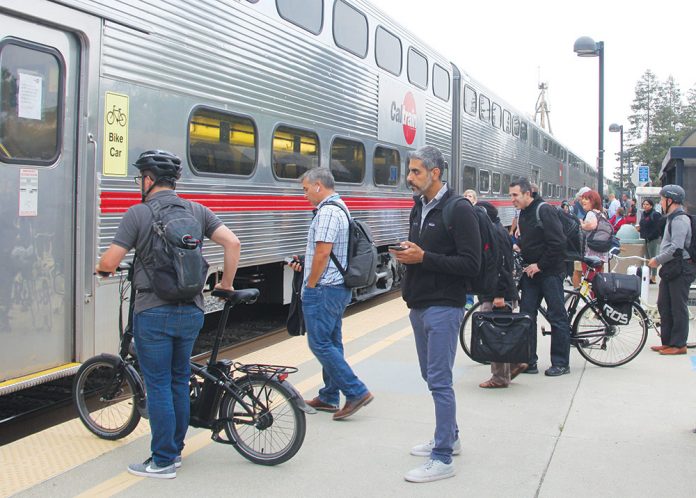The 40-year dream of restoring passenger rail service—stoked by increasing population and traffic congestion—from Gilroy south to Salinas and/or Hollister has found new life in two counties.
Monterey County officials this week began construction of an $81 million project to build a new train station and other railroad upgrades, which they claim could bring daily railroad service to Gilroy and the Bay Area by 2020.
Meanwhile, San Benito county transportation officials this spring received a $150,000 grant for an “in-depth feasibility assessment of public transit projects, including passenger rail, to help reduce congestion along Highway 25.”
One problem: No railway company has committed to, or even expressed an interest in, providing the rail service.
The Capitol Corridor Joint Powers Authority, which contracts with BART to operate rail service between Sacramento and San Jose, is the latest favorite of the Transportation Agency of Monterey County for the San Jose-Gilroy passenger rail.
Caltrain, the initial choice, told the Dispatch this week, “There has been no commitment made that Caltrain would be responsible for operating the service” from San Jose to Salinas through GIlroy.
Six Caltrain trains—three northbound in the early morning commute and three southbound in the evening commute—currently connect the Bay Area to and from the Gilroy station, with stops in San Martin and Morgan Hill.
Some folks may still remember the last passenger train to stop in Hollister at the Fifth Street depot, on Oct. 30, 1955. The Gilroy-to-Hollister rail route opened in 1871. The old train station since 2007 has been the home of El Epazote Restaurant.
WIth much fanfare, Monterey officials held a groundbreaking ceremony Aug. 9 at the Salinas Train Station to celebrate “the Monterey County Rail Extension–Kick Start Project” to extend passenger rail service from Santa Clara County to the City of Salinas.
“The project will provide an alternative to traffic congestion, thereby reducing commuter stress and increasing productivity. The extension will provide access to jobs, health care, education and shopping, and expand transportation options for the young, elderly and disabled,” touted the Monterey agency in a press release. The event was cited as “an unprecedented collaboration of state and regional transportation agencies, along with local jurisdictions.”
The proposed route would follow Union Pacific tracks that roughly parallel state Highway 129. The lone Amtrak train, the Coast Starlight linking San Diego and Vancouver, follows this route—northbound in the early evening and southbound mid-mornings. This is the closest passenger train to Hollister, but the San Benito Council of Governments will be studying its own possible Caltrain extension. A Tres Pinos branch line of this rail route extends east past San Juan Bautista to Hollister.
The Union Pacific is the main rail freight system in the region. One Salinas city councilmember last week said that Monterey officials would also be reaching out to Union Pacific as a possible provider of the new passenger service, but the railway stopped all of its passenger trains in the U.S. in 1971.
Plans to link either the Capitol Corridor, which now ends in San Jose, or Caltrain, which now ends service at Gilroy, could be in place “optimistically by 2020,” said Christina Watson of the Transportation Agency for Monterey County.
Originally, the project was to extend Caltrain to Salinas, according to Monterey County officials.
Then the plan changed to extending the Capitol Corridor train, which connects Sacramento with San Jose.
Another project in the mix is the California High Speed Rail, which would reach from Gilroy to Merced, then to Los Angeles.
Caltrain, along with many other regional rail operators and the state, has been involved with planning efforts to establish rail service between Monterey County and the Bay Area. However, there has been no commitment from Caltrain to be responsible for operating the service.
“The Transportation Authority of Monterey County has been working on this effort for many years, but the effort is still in its infancy and no operator has been identified,” Caltrain said in a statement this week in response to inquiries from the Dispatch.
“Significant planning, capital improvements, actions and agreements involving many parties would be required before any service could be considered for operation. As a key part of the region’s rail network, Caltrain staff will continue to participate in these discussions.”
The Council of San Benito County Governments and San Benito County Local Transportation Authority, which oversees San Benito County Express, received a $150,000 competitive SB1 transportation planning grant award from Caltrans. The funds will be dedicated to an in-depth feasibility assessment of public transit projects, including passenger rail, to help reduce congestion along Highway 25.
Highway 25 is highly congested during weekday commute hours due to the large number of residents commuting to Santa Clara County. The average daily traffic at the San Benito/Santa Clara county line has more than doubled since the mid-1990s due to rapid population growth and commute trips, and is expected to double again by 2040.
The study will include public engagement, stakeholder participation, the evaluation of public transit projects, high-level implementation strategies, project cost estimates and the identification of funding strategies, COG said in a press release.
Work with a consultant began this summer with community outreach starting later this year.
Project updates and information on how to get involved will be provided on the San Benito County Express website at www.SanBenitoCountyExpress.org.
Senate Bill 1 provides approximately $5.4 billion in annual funding to fix roads, freeways and bridges and puts more dollars toward transit and safety. For complete details on SB 1, visit the state’s website at http://www.rebuildingca.ca.gov.
Census information indicates that 48.9 percent of employed San Benito County residents commute outside of the county for employment. As the population of the county continues to increase at a rate higher than the employment opportunities, current congestion issues for personal automobiles will continue to increase, including along Highway 25.














